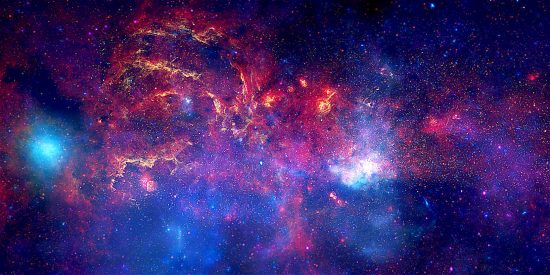
The central region of the Milky Way. The center of the galaxy is located within the bright white region to the right and just below the middle of the image. Yellow is near-infrared observations from the Hubble Space Telescope. Red indicates infrared observations from the Spitzer Space Telescope. Blue and violet are X-ray observations from the Chandra X-Ray Observatory. Credit: NASA, ESA, SSC, CXC and STScI. Click to enlarge.
Jul 27, 2018
Gravity is given far too much influence.
Almost all galaxies are said to harbor one or more black holes. Since matter is supposed to spin around a black hole at extreme velocities, consensus opinions state that it heats up from friction, generating X-rays and ultraviolet light. It is those emissions that are interpreted as indirect evidence for black holes.
Previous Pictures of the Day take issue with the terminology, itself, as highly speculative and ambiguous. Gravitational tides from a supermassive black hole in the center of the Milky Way, for example, are invoked in order to explain how stars are destroyed and remade. To say that X-rays and ultraviolet light in space are created in gravity fields is to betray an ignorance. Experiments in the laboratory create those energies by accelerating charged particles through an electric field.
There is no experiment that can provide evidence for matter collapsed to “near infinite density”. Rather, Bennet pinches (z-pinches) in plasma-state material form plasmoids that then become stars. When the electric flux inside double layers within galactic circuits gets too high, there is a sudden “short circuit” that draws energy from the surrounding space. Rather than “star-shredder” gravitational forces, that energy is concentrated from hundreds of cubic light years and then discharged in a burst of cosmic lightning, generating X-rays or flares of ultraviolet light.
According to a recent press release, a star called, S2 “….reveals an effect called gravitational redshift.” The light from S2 is said to be “stretched” by gravitational redshift into longer, or redder, wavelengths by its motion around Sagittarius a*, the putative supermassive black hole in the center of the Milky Way.
In an Electric Universe, electromagnetism is more than able to create celestial phenomena, without the supernatural physics of supermassive black holes. Plasma discharge events are commonly known to generate high-energy light. The greater the electric charge flow, the higher the frequency of light will be emitted. Supply enough power and even gamma rays are released.
X-ray radiation from a plasmoid in the Milky Way’s heart is the same as from stars undergoing strong electrical stresses. A plasmoid is a charged particle accelerator, so electrons spiral in the electromagnetic fields and give off X-rays. The diffuse currents then flow toward the galaxy’s equatorial plane and spiral back toward the core.
These papers argue that new theories should not be built upon the questionable assumptions of other theories. The list of events derived from computer simulations that are based on foregone conclusions continues to grow, however. Plasma physicist and Electric Universe pioneer, Hannes Alfvén, proposed that an “exploding double layer” ought to be a new class of celestial object. Double layers in space plasmas form most of the unusual structures that give conventional astronomers headaches. Supernova explosions, galactic jets, glowing rings, and anomalous acceleration are examples of how electricity behaves when it moves through dusty plasma.
Gigantic masses compressed into tiny volumes are unnecessary: laboratory experiments create flares, jets, and other celestial events using mundane electrical equipment. No supercomputer simulations are necessary, since the experiments can be conducted in real time. Electricity is responsible for galaxies and stars. When current density gets too high, double layers in those circuits explode, appearing as gamma ray bursts, or X-rays, or flares of ultraviolet light. Although, astronomers believe that those observations are due to gravity’s influence, with no mention of electric charge.
That electric charge flow also distorts visible light through the Zeeman effect. When light passes through an electromagnetic field, it is split into different spectral lines. That electrical phenomenon is what astronomers mistake for gravitational redshift.
Stephen Smith












